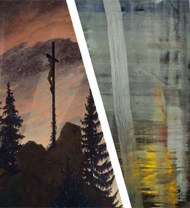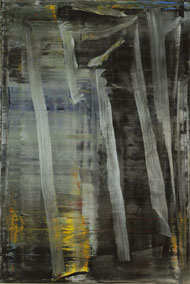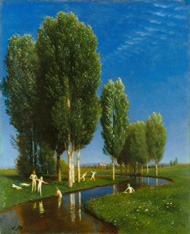 |

 |
 |
Left: Cross in the Mountains (Tetschen Altar) (detail), Caspar David Friedrich, 1807–1808
Right: Wald (892-3) (detail), Gerhard Richter, 2005 © Gerhard Richter
|
 |
 |
|
The city of Dresden has been a major center of German art since the 1700s. This exhibition, part of the Getty's ongoing partnership with the Dresden State Museums, was curated in collaboration with the Galerie Neue Meister. It explores several recurring themes found throughout German art from 1800 to the present: Romanticism and the sublime, the relationship between German art and that produced elsewhere in Europe, the connection between history and art in Germany, and the role of Dresden in the development of German art.
The exhibition is organized in two parts. One part compares the work of the two best-known artists associated with Dresden—Caspar David Friedrich (1774–1840) and Gerhard Richter (born 1932). The other part presents 13 works from the Galerie Neue Meister collection interspersed throughout the Getty's paintings galleries, which span the period between Friedrich and Richter.
|
 |
|
Though separated by well over a century, Friedrich and Richter both used abstraction, expansiveness, and emptiness to express transcendent emotion through painting. Rather than drawing a direct line of influence from Friedrich to Richter, or arguing that both artists demonstrate inherently German characteristics, this exhibition suggests the artists' similar approaches to landscape.
See the works of Friedrich and Richter side-by-side.
|
 |

 |
 |
Cross in the Mountains (Tetschen Altar), Caspar David Friedrich, 1807–1808
|
 |
 |
Around 1800, Caspar David Friedrich revolutionized painting in Europe. Rather than working in the figural mode, rooted in ancient art, that had been the cornerstone of Western European art for centuries, Friedrich remained in German lands and made landscape his primary subject.
Friedrich based his work from drawings he made in different parts of Germany. He used this landscape to convey powerful feelings—a subjective, romantic response to the natural world.
In the painting seen here, the dramatic silhouette, the abrupt break from foreground to background, and the diminished perspective all mark decisive breaks with traditional conventions of landscape painting. The devotional cross in the wilderness, a common sight in the German countryside, suggests a Christian theme. Rather than expressing specific beliefs through traditional sacred narratives, Friedrich used landscape to create a mood that conveys religious meaning. He encouraged his viewers to have a personal, spiritual experience through their own emotional responses to the landscape. In this way, he used this landscape to convey powerful feelings—a subjective, romantic response to the natural world.
|
 |
 |

 |
 |
Wald (892-3), Gerhard Richter, 2005
© Gerhard Richter
|
 |
 |
|
Born in Dresden in 1932, Gerhard Richter trained in Dresden's art academy in communist East Germany. He moved to West Germany in 1961 where he quickly altered his realist style in response to Abstract and Conceptual art from America and Europe. Richter's paintings seem to acknowledge the failure of art to represent the world meaningfully while also presenting their beautifully crafted, complex surfaces for our contemplation.
For this exhibition, Gerhard Richter has selected a series painted in 2005. Initially titled Abstract Painting, Richter renamed the series Wald (Woodlands) earlier this year.
Made with paint-loaded squeegees, which scrape the upper layers while revealing other colors below, these contemplative, absorptive paintings evoke various moods associated with woodlands. These works engage with the sublime emotion of Friedrich's paintings and also place themselves within the long history of painting in Dresden.
|
 |

 |
 |
Summer Day, Arnold Böcklin, 1881
|
 |
 |
|
|
 |
The second part of this exhibition displays 13 German paintings from the Galerie Neue Meister in Dresden, one of the great collections of modern and contemporary German art, alongside works from the Getty's permanent collection. Rather than following a strict chronology, these juxtapositions touch on key themes in German painting from 1800 to the present.
Explore a selection of comparisons from the exhibition.
The exhibition has been co-organized by the J. Paul Getty Museum and the Galerie Neue Meister, Staatliche Kunstsammlungen Dresden.
The exhibition is located at the Getty Center, Museum, West Pavilion.
|
 |



